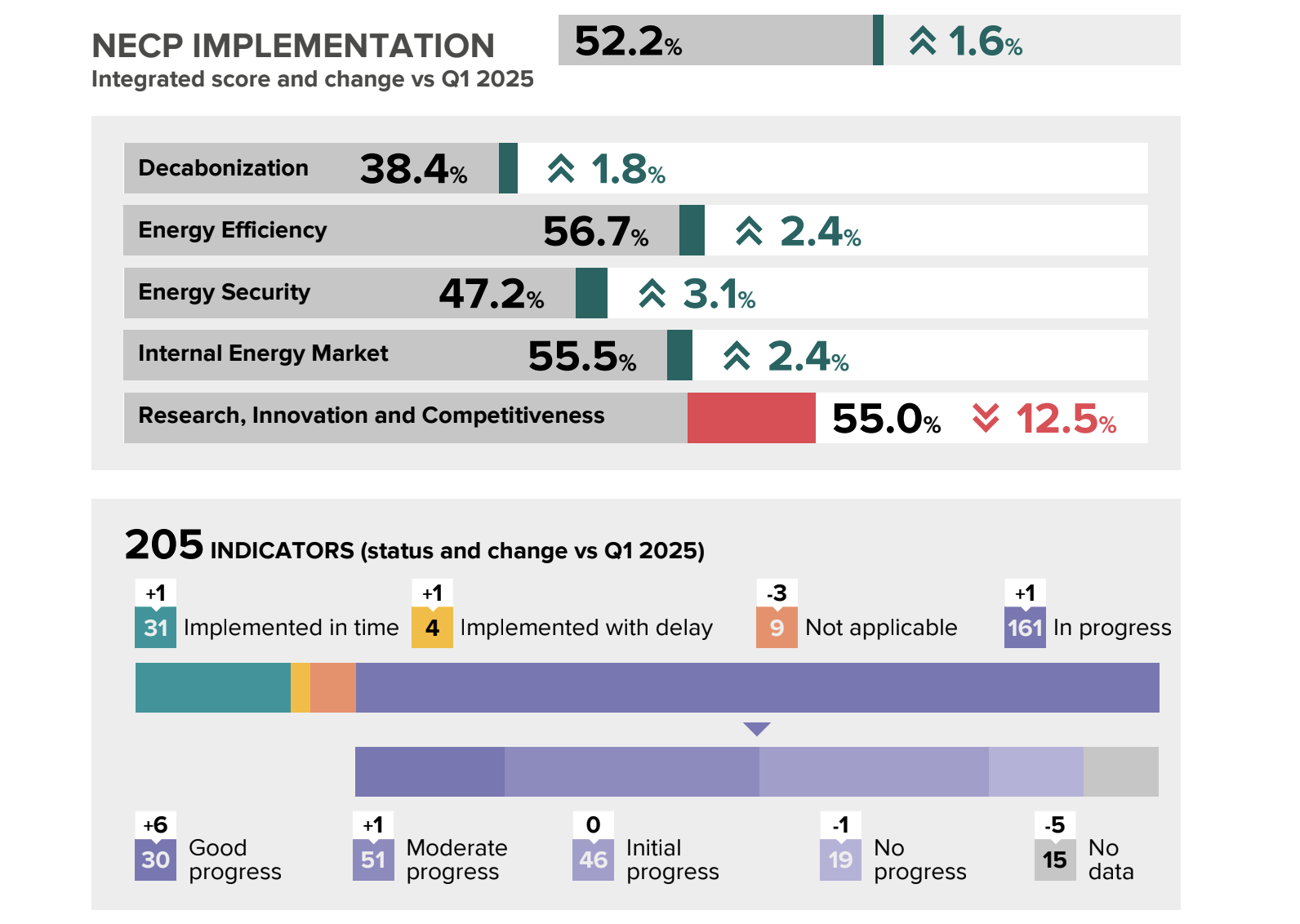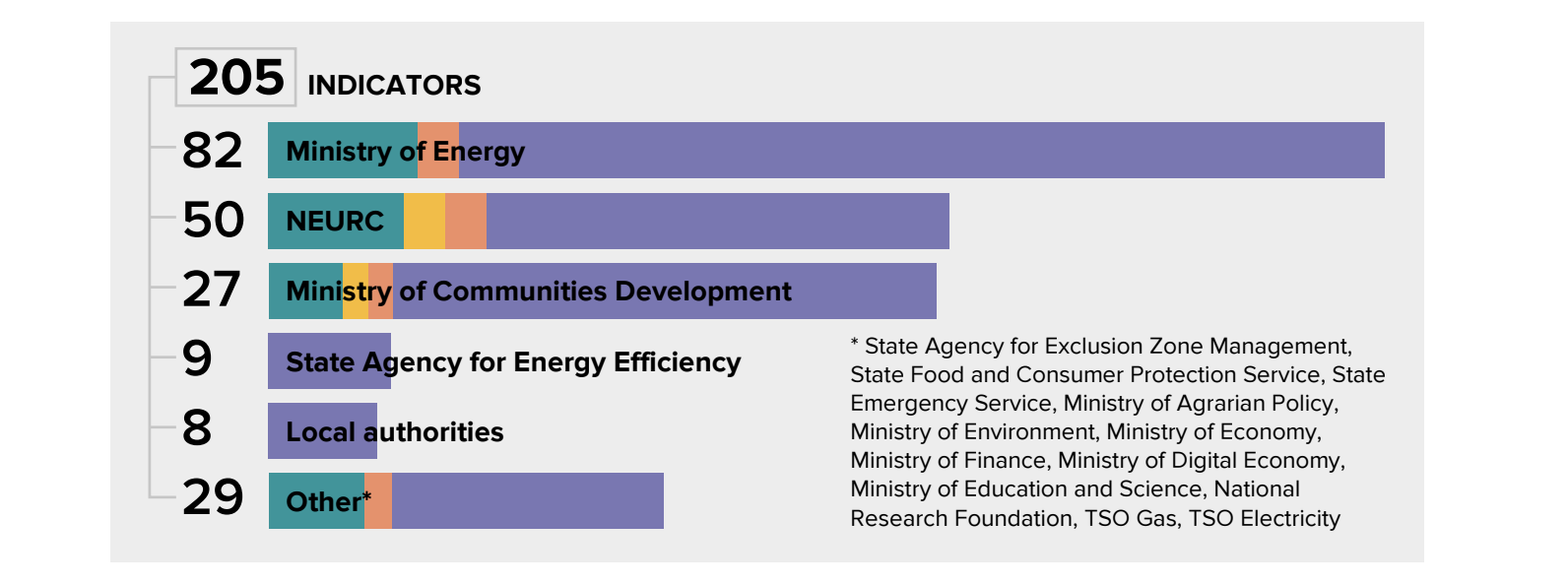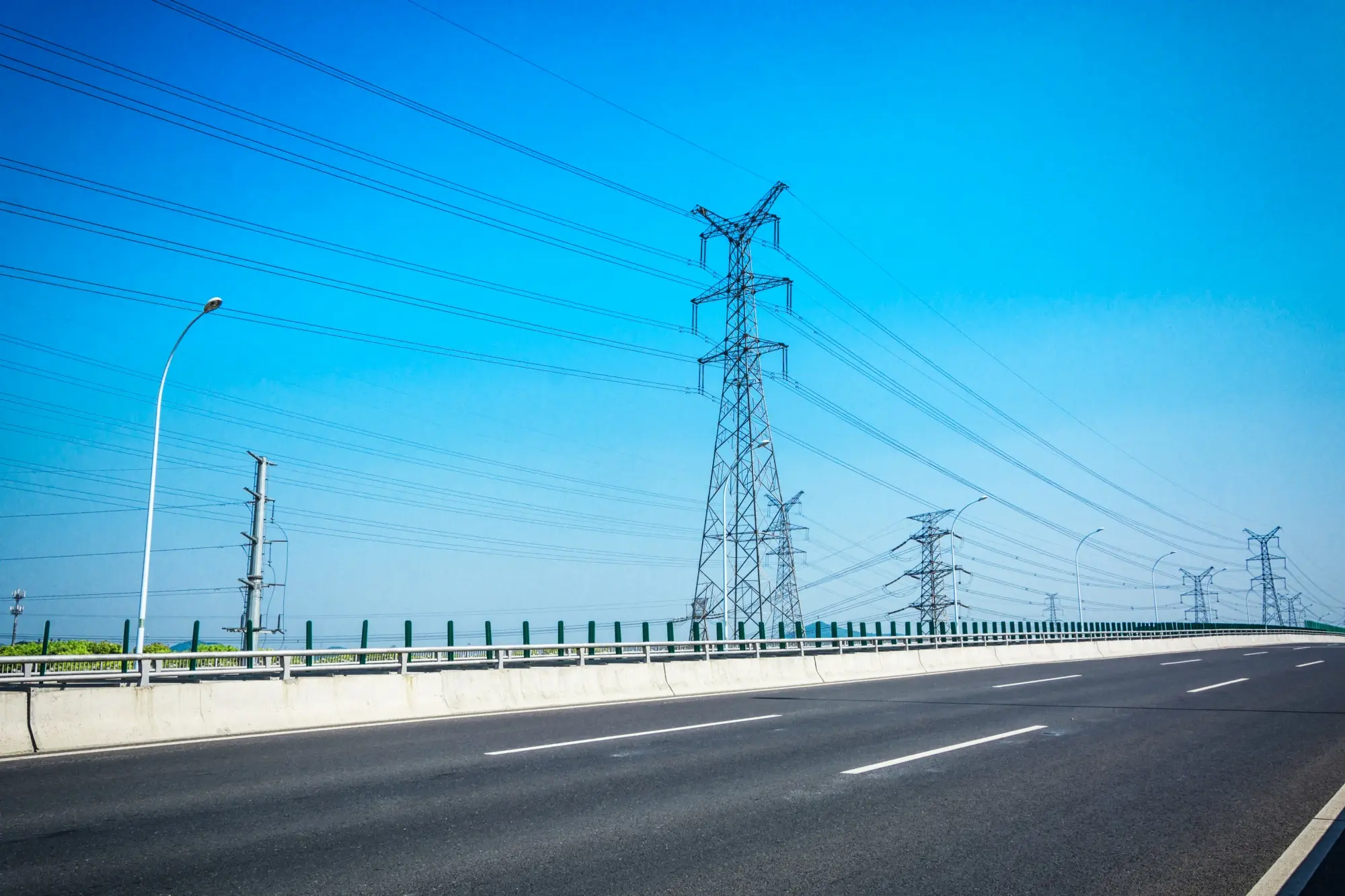SUMMARY
The assessment of the National Energy and Climate Plan (NECP) implementation is performed on the basis of 205 indicators for all 144 policies and measures, both existing and planned as defined by Regulation (EU) 2018/1999. Existing policies and measures include those implemented and adopted as of NECP approval in June 2024.


In the second quarter of 2025, the implementation of the NECP showed better progress than in the previous period. Advancements were recorded in four dimensions and at least 23 policies and measures, with worser performance for only 3 policies and measures.
Key decisions and events:
- The Cabinet of Ministers Resolution No. 583 established an Interagency Working Group on Monitoring the NECP Implementation, which strengthens the coordination of authorities involved in its implementation.
- The draft of the second Nationally Determined Contribution to the Paris Agreement has been published, which envisages a reduction in greenhouse gas emissions by 68-73% by 2035 compared to 1990 levels.
- The Cabinet of Ministers Resolution No. 711 approved the State Targeted Program for Just Transition of Coal Regions by 2030, which paves the way for the socio-economic restructuring of these territories.
- A revised draft law No. 12087-d has been submitted to the Verkhovna Rada on the integration of Ukrainian and European electricity markets (market coupling), the development of new business models, and the flexibility of energy system.
- The Cabinet of Ministers Order No. 612-r approved the Roadmap of the Process of Separation of the Renewable Energy Surcharge from the Transmission Tariff.
- In May, the first-ever exports of liquified biomethane from Ukraine took place, demonstrating the prospects for the development of the low-carbon and renewable gases industry and the potential for diversification of its deliveries.
- Since June, a “super-bundled” capacity product from Greece to Ukraine has become available for booking, facilitating LNG imports and increasing competition among gas supply routes.
- The Cabinet of Ministers Resolution No. 547 approved the Regulation on the Information Database of Natural Gas Consumption, which is the first step towards creating a database similar to the Datahub in the electricity market.
- The government has approved the contingency plan to overcome crisis situations in the market of crude oil and petroleum products, as part of the minimum stocks system.
- Ukrenergo contracted 249 MW of reserves (aFRR). In total, through the mechanism of long-term procurement of ancillary services, the TSO purchased 788 MW of reserves (FCR and aFRR).
- The State Fund for Decarbonization and Energy Efficient Transformation provided a record number of loans for over UAH 186 million (a total of 16 projects).
- The National Database of Energy and Performance Characteristics of Buildings already provides access to over 2,100 documents on the technical and energy characteristics of buildings.
- The Energy Efficiency Fund received EUR 18 million from the EU and Germany to continue its activities, and the grant policy of the VidnovyDIM program was also updated with an expansion of eligible activities.
The Cabinet of Ministers Resolution No. 583 established an Interagency Working Group on Monitoring the
NECP Implementation, which strengthens the coordination of authorities involved in its implementation.
■ The draft of the second Nationally Determined Contribution to the Paris Agreement has been published,
which envisages a reduction in greenhouse gas emissions by 68-73% by 2035 compared to 1990 levels.
■ The Cabinet of Ministers Resolution No. 711 approved the State Targeted Program for Just Transition of Coal
Regions by 2030, which paves the way for the socio-economic restructuring of these territories.
■ A revised draft law No. 12087-d has been submitted to the Verkhovna Rada on the integration of Ukrainian
and European electricity markets (market coupling), the development of new business models, and the
flexibility of energy system.
■ The Cabinet of Ministers Order No. 612-r approved the Roadmap of the Process of Separation of the
Renewable Energy Surcharge from the Transmission Tariff.
■ In May, the first-ever exports of liquified biomethane from Ukraine took place, demonstrating the prospects
for the development of the low-carbon and renewable gases industry and the potential for diversification of
its deliveries.
■ Since June, a “super-bundled” capacity product from Greece to Ukraine has become available for booking,
facilitating LNG imports and increasing competition among gas supply routes.
■ The Cabinet of Ministers Resolution No. 547 approved the Regulation on the Information Database of Natural
Gas Consumption, which is the first step towards creating a database similar to the Datahub in the electricity
market.
■ The government has approved the contingency plan to overcome crisis situations in the market of crude oil
and petroleum products, as part of the minimum stocks system.
■ Ukrenergo contracted 249 MW of reserves (aFRR). In total, through the mechanism of long-term procurement
of ancillary services, the TSO purchased 788 MW of reserves (FCR and aFRR).
■ The State Fund for Decarbonization and Energy Efficient Transformation provided a record number of loans
for over UAH 186 million (a total of 16 projects).
■ The National Database of Energy and Performance Characteristics of Buildings already provides access to
over 2,100 documents on the technical and energy characteristics of buildings.
■ The Energy Efficiency Fund received EUR 18 million from the EU and Germany to continue its activities, and
the grant policy of the VidnovyDIM program was also updated with an expansion of eligible activities.
The development of efficient, decarbonized district heating systems is critical to achieving the NECP goals. The “Special Topic” section examines the main provisions of the draft law “On Amendments to Certain Laws of Ukraine on Supporting the Development of Efficient and Sustainable District Heating”, published by the Ministry for Development of Communities and Territories, analyzes the compliance of its provisions with the requirements of EU acquis, and provides recommendations for their improvement.
Monitoring is performed on the basis of public sources of information, but may also include requests for information, consultations or other methods (as noted separately). The assessment of the NECP implementation is carried out on the basis of qualitative and quantitative indicators for all 144 policies and measures. All indicators are assessed in two aspects – the status of implementation and the status of progress (for policies and measures in the process of implementation). A detailed description of the scale, as well as the assessments by indicators with relevant comments, can be viewed in the assessment table for Q2 2025. In addition to assessing the indicators, the experts also take into account decisions and events that directly relate to the NECP and/or may have a significant impact on its implementation.
The publication was prepared with the financial support of the UK Agency for International Development under the project “Implementation of the National Energy and Climate Ukraine Plan and establishment of the Green Economic Transition Office” implemented by DIXI GROUP NGO. The contents of the publication are the sole responsibility of DIXI GROUP NGO and under no circumstances can be considered to reflect the position of the UK Agency for International Development.
